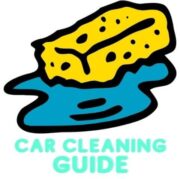Last Updated on September 22, 2023 by Chase Manhattan
WD-40, an American brand of water-displacing sprays, is well-known for its wide range of uses, from lubricating squeaky door hinges to removing stubborn stains. But one of the most intriguing questions that often arise is: does WD40 remove paint?
To answer this, we must delve into the numerous ways WD-40 can be utilized, focusing on its effectiveness in dealing with unwanted paint splatters. We will explore how WD-40 can tackle paint-related issues, including removing paint transfer from your car or getting rid of spray paint mishaps, and even if it’s effective on glass surfaces. So lets keep going, and get to it!
- How to Clean Car Carpets Quick and Easy - July 10, 2024
- Can You Touch Up Clear Coat? Yes and No (Here’s Why) - November 25, 2023
- How To Wax A Car By Hand: A Comprehensive Guide - November 14, 2023
Quick Navigation
WD-40: An Overview
Before we delve into the question, “does WD40 remove paint?”, it is essential to understand what WD-40 is and its primary uses. WD-40 is a product of the WD-40 Company, which was initially created in 1953 for the aerospace industry. Its name stands for “Water Displacement, 40th formula,” indicating that it took the company 40 attempts to perfect the formula.
The product is known as a lubricant, degreaser, and rust remover, typically found in a blue and yellow aerosol can with a red straw nozzle. It’s a staple in many households, with an estimated 80% of homes having at least one can on hand.
WD-40 has been reported to have over 2,000 uses, ranging from cleaning tools, fixing squeaky hinges and wheels, to preventing rust. However, its ability to deal with paint-related problems is what we will focus on in this article.
Brief Overview Table
| Aspect | Does WD-40 Remove Paint? | Remove Paint Transfer from Car with WD-40 | Will WD-40 Remove Paint from Glass? |
|---|---|---|---|
| Effectiveness | Not specifically designed as a paint remover. May help loosen certain types of paint, but not a primary paint removal method. | Can be helpful in removing paint transfer from a car's surface. Apply cautiously and test on a small area first. | Can sometimes help remove minor paint stains or overspray from glass. Use with care to avoid scratches. |
| Recommended Usage | Not recommended as a primary paint removal method. Use appropriate paint removers for effective results. | Can be used for minor paint transfer. Apply a small amount to a clean cloth and gently rub the affected area. | Suitable for minor paint stains on glass. Apply WD-40 to a cloth and gently rub the area. Avoid excessive force to prevent damage. |
| Precautions | Test on a small, inconspicuous area first to avoid potential damage to the surface. | Be cautious not to use excessive force or aggressive rubbing, as it may damage the car's paint. | Avoid using WD-40 on tinted glass or sensitive surfaces. Test in a small area first. |
| Best Practices | Use WD-40 sparingly and for specific spot cleaning purposes only. Follow instructions and guidelines on the WD-40 can. | Always spot test before widespread use on the car's surface. After applying WD-40, clean the area thoroughly with soapy water to remove any residue. | Apply WD-40 gently and avoid applying near surrounding paintwork. Clean the area with glass cleaner afterward. |
Unveiling the Mystery: Does WD40 Remove Paint?
The answer is yes, WD40 can help remove paint. Its lubricating properties can break down the paint, making it easier to wipe off. Whether it’s an accidental paint splatter on your car or a botched DIY project, WD-40 can come to your rescue. However, the method and effectiveness can vary depending on the type of paint and surface from which it needs to be removed.
Using WD-40 to Remove Paint Transfer from Cars
One of the most common uses of WD-40 in relation to paint is removing paint transfers from cars. Paint transfers occur when a car rubs against a painted object, and the paint from that object transfers onto the car’s surface. This is a common issue for many car owners and can be a real eyesore.
To use WD-40 to remove paint transfer from your car, follow these steps:
- Clean the affected area: Start by washing the area around the paint transfer with soap and water. This will remove any dirt or debris that could potentially scratch your car’s surface during the paint removal process.
- Apply WD-40: Spray WD-40 directly onto the paint transfer. Let it sit for a few minutes to allow for the WD-40 to penetrate and break down the paint.
- Rub off the paint: Use a clean, soft cloth, or a magic eraser to gently rub the area. The paint transfer should start to lift off. Be careful not to rub too hard as it could potentially damage the car’s original paint.
- Clean the area again: Once the paint transfer is removed, wash the area again with soap and water to remove any remaining WD-40 residue. Then, dry the area with a clean towel.
WD-40 to Remove Spray Paint from Cars
Similar to paint transfers, WD-40 can also be used to remove unwanted spray paint from your car. Whether it’s an unfortunate encounter with a graffiti artist or an accidental overspray from a DIY project, WD-40 can effectively remove spray paint without damaging your car’s original factory paint job.
To use WD-40 to remove spray paint from your car, you can follow the same steps as above. However, it is important to note that you may need to repeat the process several times for stubborn paint stains. Always remember to wash and dry the area thoroughly after each round to ensure no WD-40 residue is left behind.
Reference Video
Will WD-40 Remove Paint from Glass?
It’s not just cars that can benefit from WD-40’s paint-removing properties. If you find yourself asking, “Will WD 40 remove paint from glass?” the answer is a resounding yes. It can work wonders in removing paint splatters or overspray from glass without causing any scratches or marks.
To remove paint from glass using WD-40, follow these steps:
- Clean the glass: Start by cleaning the surface of the glass to remove any dirt or debris.
- Apply WD-40: Spray WD-40 directly onto the paint on the glass. Let it sit for a few minutes to allow it to break down the paint.
- Scrape off the paint: Use a plastic scraper or a razor blade to gently scrape off the paint. Be careful not to scratch the glass.
- Clean the glass again: Once the paint is removed, clean the glass again to remove any remaining WD-40 and paint residue.
Other Notable Uses of WD-40
While the ability of WD-40 to remove paint is impressive, it is just the tip of the iceberg. Here are some other notable uses of WD-40:
Removing Bugs from Cars
WD-40 is not only great at removing unwanted paint from cars, but it can also help get rid of stubborn bugs that stick to your car’s bumper, grill, or windshield. Simply spray WD-40 onto the bugs, let it sit for a few minutes, then wipe them off with a cloth.
Lubricating Mechanical Parts
WD-40 is a superb lubricant for squeaky door hinges, sticking drawers, jammed zippers, and other mechanical parts. A small spray of WD-40 can make them function smoothly again.
Rust Removal
WD-40 can also help remove rust from various objects, including tools and car parts. Plus, it can protect these items from future rusting, extending their lifespan.
Removing Gum and Glue
WD-40 is effective in removing gum or glue stuck on various surfaces. Spray WD-40 onto the sticky residue and it should start to come off easily.
Related article: WD-40 Alternatives for Car Use
Points of Caution when Using WD-40
While WD-40 is a handy tool to have around, there are certain things to keep in mind when using it. It is important to remember that WD-40 can be harmful to certain types of plastics such as polycarbonate and clear polystyrene. So, be careful when using it around plastic moldings or surfaces.
Also, avoid using WD-40 on electronic devices as it can potentially damage the circuitry if it gets into the wrong parts. Always use WD-40 with caution and follow the manufacturer’s instructions.
In addition, WD-40 is combustible, meaning it can catch fire if exposed to a source of heat. Therefore, always store it in a cool, dry place away from any heat sources or open flames, and keep it out of reach of children and pets.
FAQs and Related Questions
Does WD-40 remove paint?
WD-40 is not specifically designed as a paint remover, but it can be used as one in a pinch – following certain protocols. While it may help loosen certain types of paint, using it as a primary paint removal method is not recommended. Instead, consider using appropriate paint removers or seek professional advice for safe and effective paint removal.
Can WD-40 remove paint transfer from a car?
WD-40 can be helpful in some cases to remove paint transfer from a car’s surface. Apply a small amount of WD-40 to a clean cloth and gently rub the affected area to see if the transfer can be lifted. However, be cautious and test on a small, inconspicuous spot first to avoid any potential damage to the car’s paintwork.
Will WD-40 remove paint from glass?
WD-40 can sometimes help in removing minor paint stains or overspray from glass surfaces. Apply WD-40 to a clean cloth and gently rub the affected area to see if the paint can be lifted. However, be careful not to use excessive force, as it may cause scratches. For more substantial paint removal on glass, consider using specialized glass cleaners or consult a professional for assistance.
Conclusion
So, does WD40 remove paint? Absolutely. Whether it’s a paint transfer from another vehicle, an unfortunate encounter with a graffiti artist, or a DIY project gone wrong, WD-40 can help you remove the unwanted paint safely and effectively. But remember, while this versatile product can solve many problems, it should always be used with caution and stored safely.


